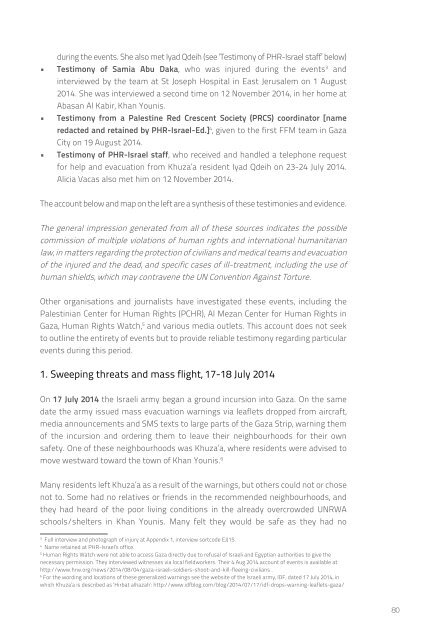HHo0s
HHo0s
HHo0s
Create successful ePaper yourself
Turn your PDF publications into a flip-book with our unique Google optimized e-Paper software.
during the events. She also met Iyad Qdeih (see ‘Testimony of PHR-Israel staff’ below)• Testimony of Samia Abu Daka, who was injured during the events 3 andinterviewed by the team at St Joseph Hospital in East Jerusalem on 1 August2014. She was interviewed a second time on 12 November 2014, in her home atAbasan Al Kabir, Khan Younis.• Testimony from a Palestine Red Crescent Society (PRCS) coordinator [nameredacted and retained by PHR-Israel-Ed.] 4 , given to the first FFM team in GazaCity on 19 August 2014.• Testimony of PHR-Israel staff, who received and handled a telephone requestfor help and evacuation from Khuza’a resident Iyad Qdeih on 23-24 July 2014.Alicia Vacas also met him on 12 November 2014.The account below and map on the left are a synthesis of these testimonies and evidence.The general impression generated from all of these sources indicates the possiblecommission of multiple violations of human rights and international humanitarianlaw, in matters regarding the protection of civilians and medical teams and evacuationof the injured and the dead, and specific cases of ill-treatment, including the use ofhuman shields, which may contravene the UN Convention Against Torture.Other organisations and journalists have investigated these events, including thePalestinian Center for Human Rights (PCHR), Al Mezan Center for Human Rights inGaza, Human Rights Watch, 5 and various media outlets. This account does not seekto outline the entirety of events but to provide reliable testimony regarding particularevents during this period.1. Sweeping threats and mass flight, 17-18 July 2014On 17 July 2014 the Israeli army began a ground incursion into Gaza. On the samedate the army issued mass evacuation warnings via leaflets dropped from aircraft,media announcements and SMS texts to large parts of the Gaza Strip, warning themof the incursion and ordering them to leave their neighbourhoods for their ownsafety. One of these neighbourhoods was Khuza’a, where residents were advised tomove westward toward the town of Khan Younis. 6Many residents left Khuza’a as a result of the warnings, but others could not or chosenot to. Some had no relatives or friends in the recommended neighbourhoods, andthey had heard of the poor living conditions in the already overcrowded UNRWAschools/shelters in Khan Younis. Many felt they would be safe as they had no3Full interview and photograph of injury at Appendix 1, interview sortcode EJJ15.4Name retained at PHR-Israel’s office.5Human Rights Watch were not able to access Gaza directly due to refusal of Israeli and Egyptian authorities to give thenecessary permission. They interviewed witnesses via local fieldworkers. Their 4 Aug 2014 account of events is available athttp://www.hrw.org/news/2014/08/04/gaza-israeli-soldiers-shoot-and-kill-fleeing-civilians .6For the wording and locations of these generalized warnings see the website of the Israeli army, IDF, dated 17 July 2014, inwhich Khuza’a is described as ‘Hirbat alhazah’: http://www.idfblog.com/blog/2014/07/17/idf-drops-warning-leaflets-gaza/80


